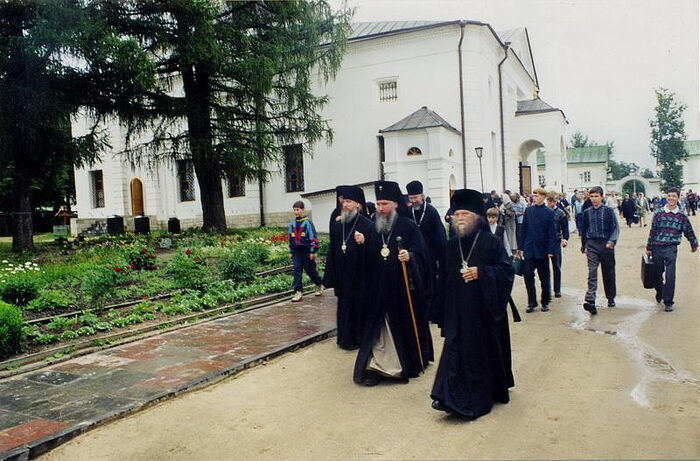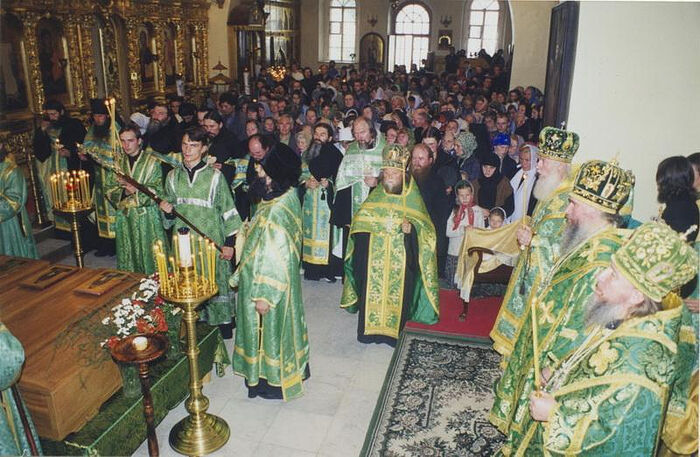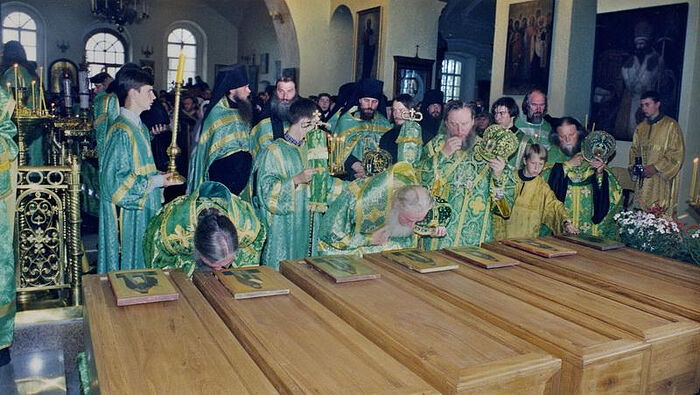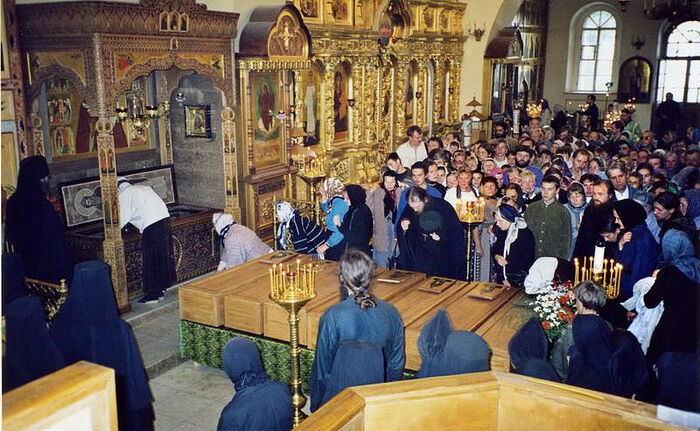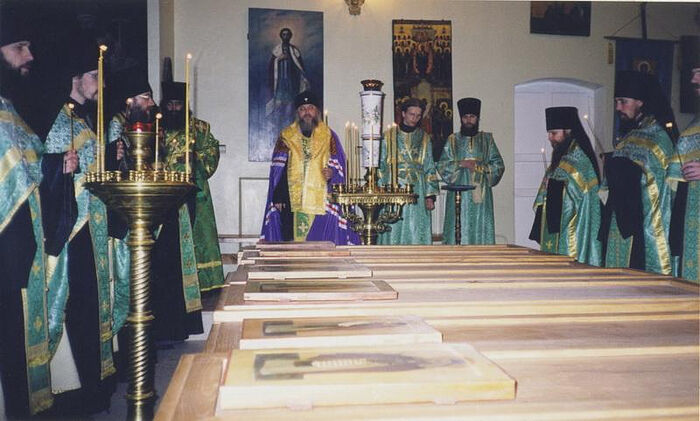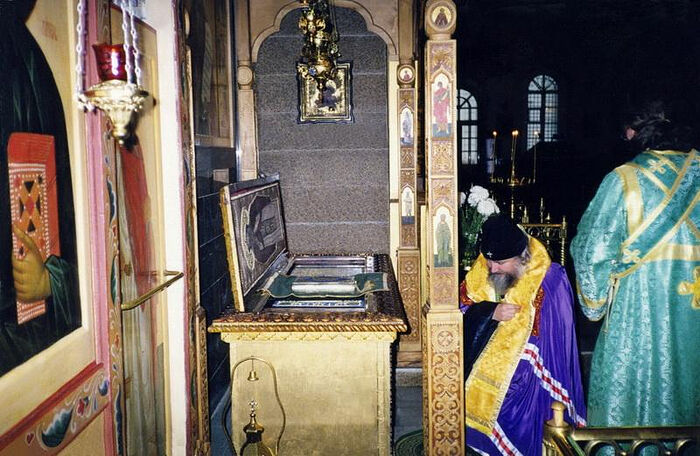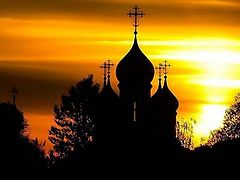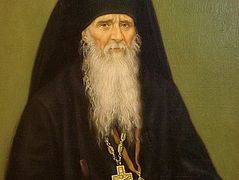On June 27/July 10, the Church celebrates the 1998 Uncovering of the Relics of the Optina Elders Leo, Macarius, Hilarion, Ambrose, Anatoly (Zertsalov), Barsanuphius, and Anatoly (Potapov). The Optina Monastery website tells the interesting story of how the relics were uncovered and identified.—Trans.
In picture A, (8) indicates the crypt where, as it was believed, the remains of those moved from the place where the St. Nicholas altar was built were reburied. It was believed there was no way the grave of Elder Leo could be located there, especially since the crypt had a completely different structure—it wasn’t laid out in the usual way, with the length running west to east, but rather from south to north.
After the remains of lay people were discovered at the supposed burial place of Elders Leo and Macarius (see picture A, (2) and (3) in Part 1), there remained only one possible option for the location of the graves of the Elders—the crypts shifted one row closer to the St. Nicholas altar. In the photos, these crypts (4, 5, 6, and 7) are shown after the removal of the top layer of earth.
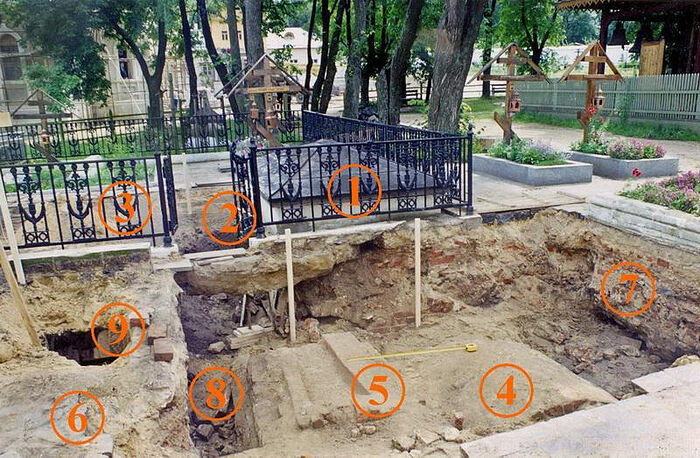 B: View of the excavation site from west to east: (1) crypt where remains were found, which until July 7, 1998, were believed to be those of St. Ambrose; (2) the site believed until July 8, 1998, to be the grave of Elder Macarius; (3) the site believed until July 8, 1998, to be the grave of Elder Leo; (4), (5), (6), (7) the crypts located one row closer to the St. Nicholas altar of the Entrance of the Theotokos Cathedral; (8) the site where they began to search for the grave of Elder Leo; (9) opening in a large transverse (from south to north) crypt (6) (also see (8) in picture A)
B: View of the excavation site from west to east: (1) crypt where remains were found, which until July 7, 1998, were believed to be those of St. Ambrose; (2) the site believed until July 8, 1998, to be the grave of Elder Macarius; (3) the site believed until July 8, 1998, to be the grave of Elder Leo; (4), (5), (6), (7) the crypts located one row closer to the St. Nicholas altar of the Entrance of the Theotokos Cathedral; (8) the site where they began to search for the grave of Elder Leo; (9) opening in a large transverse (from south to north) crypt (6) (also see (8) in picture A)
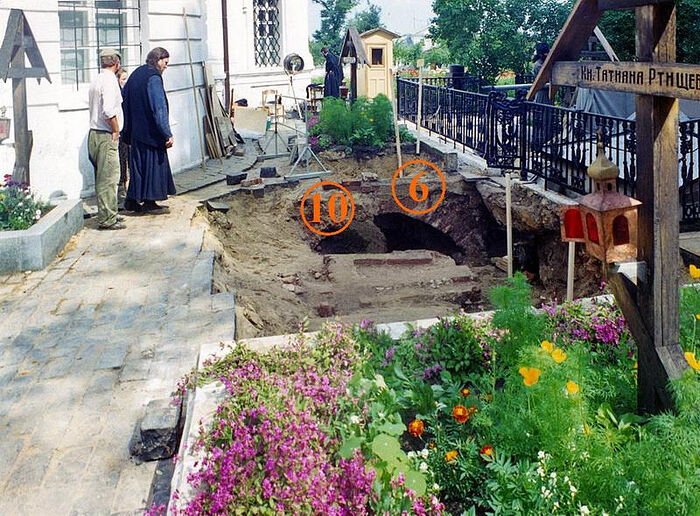 C: View of the excavation from south to north: Under the vault of the crypt (6), another crypt (10) was found, which was previously unknown.
C: View of the excavation from south to north: Under the vault of the crypt (6), another crypt (10) was found, which was previously unknown.
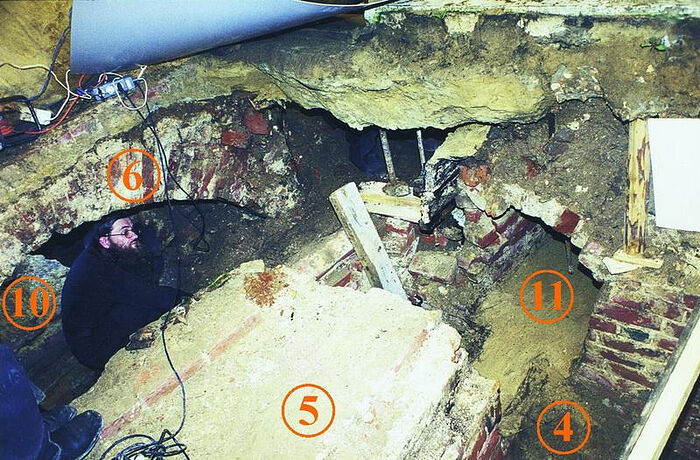 D: A very small crypt (11), the western part of which touches crypts (4) and (5), and its eastern part—crypt (1), which should now be considered the burial site of St. Joseph
D: A very small crypt (11), the western part of which touches crypts (4) and (5), and its eastern part—crypt (1), which should now be considered the burial site of St. Joseph
Photo D gives a good view of the crypts on this site:
(4) St. Ambrose;
(5) St. Macarius;
(10) St. Leo under the vault of the large crypt (6);
(11) St. Anatoly (Potapov)
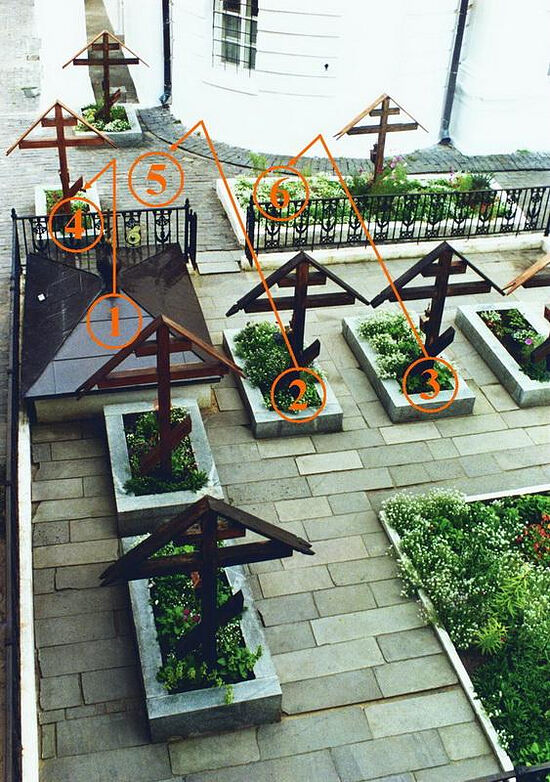 E: Another look at the necropolis before July 7, 1998. Since the excavations have shown that graves (2) and (3) most likely belong to Peter (2) and Ivan (3) Kireevsky, then the graves of Elders Macarius (5) and Leo (6) should be shifted one row closer to the St. Nicholas altar. Similarly, the grave of St. Ambrose (1) should actually be where (4) is.
E: Another look at the necropolis before July 7, 1998. Since the excavations have shown that graves (2) and (3) most likely belong to Peter (2) and Ivan (3) Kireevsky, then the graves of Elders Macarius (5) and Leo (6) should be shifted one row closer to the St. Nicholas altar. Similarly, the grave of St. Ambrose (1) should actually be where (4) is.
By July 14, the necropolis looked like this:
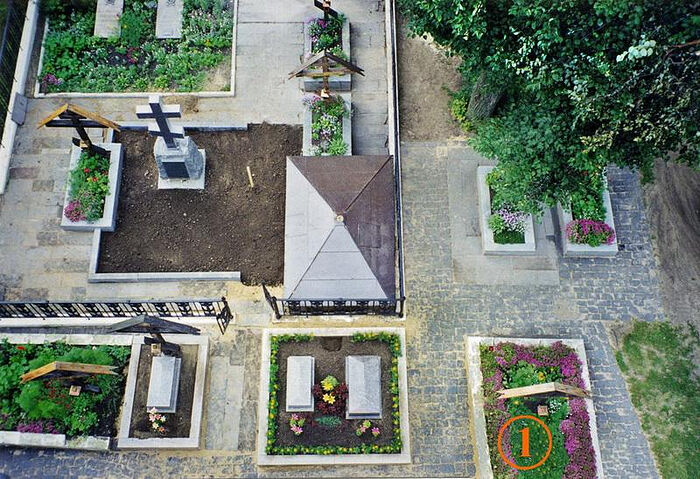 F: (1) marks the site where, as it was believed, Princess Tatiana Rtischeva was buried. However, according to the new information, the grave of Elder Hilarion should have been located on this site. And indeed, his relics were discovered here.
F: (1) marks the site where, as it was believed, Princess Tatiana Rtischeva was buried. However, according to the new information, the grave of Elder Hilarion should have been located on this site. And indeed, his relics were discovered here.
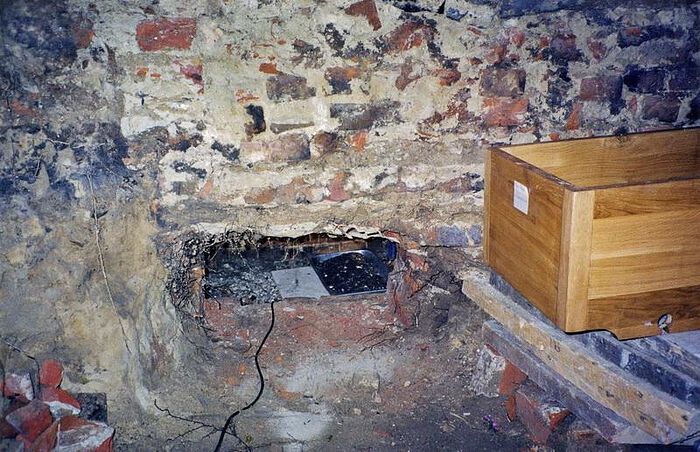 You can see the opening in the lower part of the crypt through which the work was carried out
You can see the opening in the lower part of the crypt through which the work was carried out
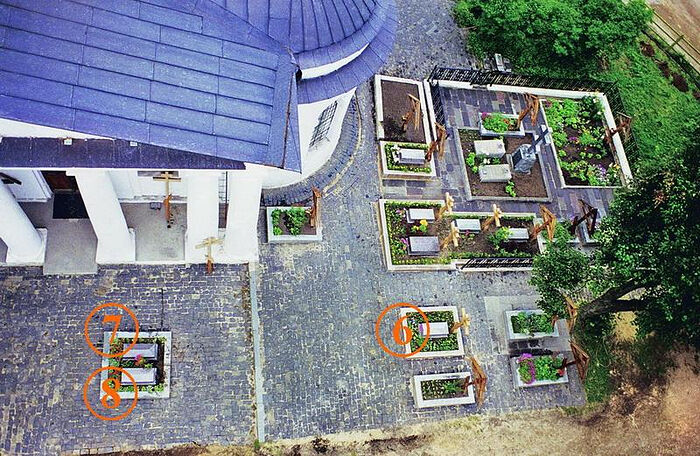 The above two photographs show a new view of the part of the necropolis where the Venerable Optina Elders were buried: (1) St. Ambrose; (2) St. Macarius; (3) St. Leo; (4) St. Anatoly (Potapov); (5) St. Joseph; (6) St. Hilarion; (7) St. Barsanuphius; (8) St. Anatoly (Zertsalov); (9) Alexei Zhelyabuzhsky; (10) the Kireyevsky brothers (the platform with the large granite cross)
The above two photographs show a new view of the part of the necropolis where the Venerable Optina Elders were buried: (1) St. Ambrose; (2) St. Macarius; (3) St. Leo; (4) St. Anatoly (Potapov); (5) St. Joseph; (6) St. Hilarion; (7) St. Barsanuphius; (8) St. Anatoly (Zertsalov); (9) Alexei Zhelyabuzhsky; (10) the Kireyevsky brothers (the platform with the large granite cross)
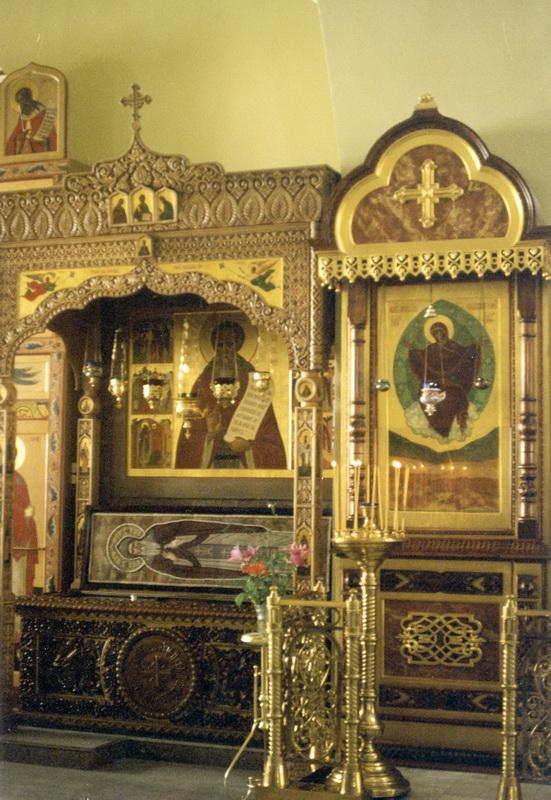 In this photo we see the reliquary under a canopy where, until July 11, 1998, rested the relics of St. Joseph of Optina, venerated as the relics of St. Ambrose.
In this photo we see the reliquary under a canopy where, until July 11, 1998, rested the relics of St. Joseph of Optina, venerated as the relics of St. Ambrose.
We recall the words about Blessed Fr. Pachomy, a clairvoyant who lived at Optina:
“He really loved Fr. Joseph, and when Fr. Joseph was still a simple monk, every time Fr. Pachomy saw him, he always asked for his blessing. ‘Fr. Pachomy, but I’m not a hieromonk,’ Fr. Joseph would say to him, smiling. ‘I’m surprised,’ Fr. Pachomy would reply. ‘Fr. Joseph is the same as Fr. Abrosim’ [meaning Fr. Ambrose. The simple folk often got the name wrong and called the elder “Abrosim”—OC].
One handmaiden of God, a fool for Christ, was with Elder Ambrose, and when she saw Fr. Joseph, she said to him: “There was an elder who had two cell attendants: One of them remained in his place.” (Life of Hieroschemamonk Joseph, Optina Monastery, 1993)
The discovered relics of St. Ambrose were placed in the reliquary instead of the relics of St. Joseph, which together with the relics of Elders Leo, Macarius, Hilarion, Anatoly (Zertsalov), Barsanuphius, and Anatoly (Potapov), were prepared to be transferred to the reliquaries in the restored Church of the Vladimir Icon of the Mother of God.
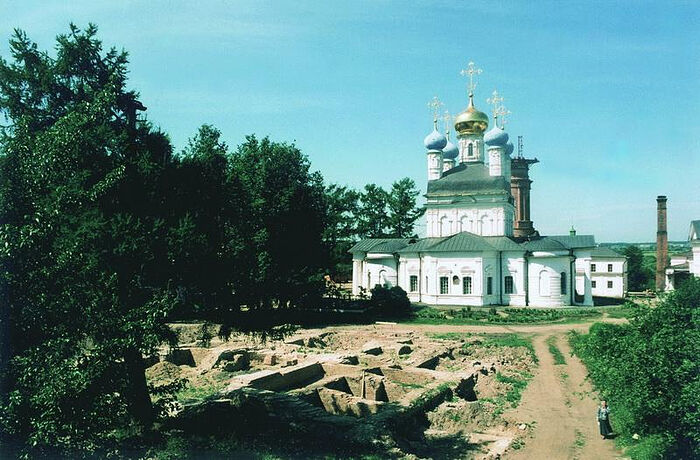 The spot where the ruined Church of the Vladimir Icon was located
The spot where the ruined Church of the Vladimir Icon was located
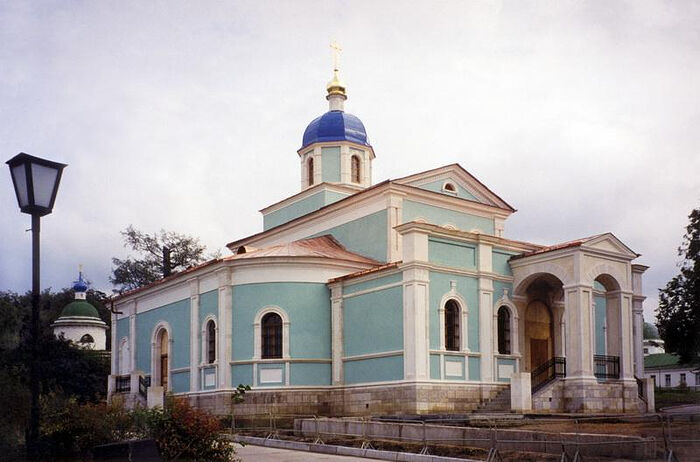 The recreated Church of the Vladimir Icon
The recreated Church of the Vladimir Icon
Granite tombstones and reliquaries were arranged in this church, where they placed the holy relics of seven Optina Elders: Leo, Macarius, Hilarion, Joseph, Barsanuphius, Anatoly (Zertsalov), and Anatoly (Potapov).
With the blessing of His Holiness, three hierarchs arrived in Optina on July 11: Archbishop Kliment of Kaluga and Borovsk, Bishop George of Lyudinovo (vicar of Abp. Kliment), and Bishop Dimitry of Tobolsk, who led a solemn moleben with an akathist before the newly discovered relics of the Optina Elders.
On August 5, 1998, a report was prepared for His Holiness in the form of an album with older and modern photo documentation, and bibliographic evidence from pre-revolutionary publications:
TO HIS HOLINESS PATRIARCH ALEXEI
OF MOSCOW AND ALL RUSSIA
Archimandrite Benedict, abbot of the Optina
Entrance of the Theotokos Monastery
REPORT
Your Holiness,
Vladyka and merciful Father!
Having received your permission to begin working on uncovering the relics of the Optina Elders: Leo, Macarius, Barsanuphius, Anatoly (Zertsalov), Joseph, Hilarion, and Anatoly (Potapov), buried on the monastery necropolis near the Entrance of the Theotokos Cathedral (resolution No. 3274, June 24, 1998), it was agreed with archaeologist S. A. Belyaev to begin work on July 8 of this year.
On July 7 (the Nativity of St. John the Forerunner), a moleben to the venerable Optina Elders was served at 2:30 PM, after which, on the advice of S. A. Belyaev, a layer of soil, approximately 20 inches, was removed from the graves of Sts. Barsanuphius and Anatoly (Zertsalov), and from the graves of Elders Macarius and Leo (or more precisely, from the supposed graves of the Elders, for the excavations showed that laymen were buried in these graves—the Kireyevskies, according to all available information).
By the middle of the day on July 8, the relics of Elders Barsanuphius and Anatoly (Zertsalov) were uncovered. No one could ever have had any doubts about the place of their burial, because the preserved photos give the clearest picture and precise landmarks for their place of burial. By this time, the work on the graves (as we thought) of Elders Macarius and Leo had been completed. Unfortunately, we saw in these graves the remains of laymen, very well preserved. One of the coffins was lined with zinc sheets; in it lay the body of a layman, dressed in clothes like a long cloak, below the knees, and feet shod in leather boots. There were still metal buttons on his clothes; around his neck was the collar of secular clothing; the sleeves of his secular clothing were well preserved. Looking somewhat in profile, we as if see the portrait of Ivan Kireyevsky himself, with his characteristic beard, with almost no hair on the middle of his chin. Moreover, it’s known that Ivan Kireyevsky’s deceased body was taken to Optina from St. Petersburg in a zinc coffin, in which he was also buried. Thus, everyone, including S. A. Belyaev was of the opinion that the discovered remains belong to the Kireyevsky brothers. According to the description, it’s known that the Kireyevsky brothers were buried near the relics of Elders Leo and Macarius (at their feet).
Of course, the results of the excavation were a surprise. However, the very fact that in the place where it was expected to see the relics of Elders Macarius Leo we saw the remains of some laymen, even regardless of who exactly these people were, inevitably demanded that we recognize that the relics of Elders Leo and Macarius must be located elsewhere, or rather that they could only be located in the row of crypts arranged closer to the Entrance of the Theotokos Cathedral. Since S. A. Belyaev had to leave for Moscow before lunch on July 9, our situation was becoming quite complicated. We had to either continue the work, guided by our own considerations, or stop. We couldn’t decide on the first, although the situation was already quite clear. And to stop the work for an indefinite period, when the excavated dirt, rocks, pavement, two large military tents, etc., lie on the territory for all to see—all this, of course, would give rise to various questions, and possibly confusion. Therefore, having consulted with the fathers of the Spiritual Council, we decided that since S. A. Belyaev hadn’t left yet, we had to continue the work without delay, especially since the conclusion about the exact location of the Elders’ graves was already undoubtedly clear.
At 3:30 PM on July 8, work began on the site closer to the altar of the Entrance of the Theotokos Cathedral. Just a little while later, a previously completely unknown crypt was discovered, and it was even believed that there shouldn’t have been a crypt on this spot. The fact is that this discovered crypt was located within another larger crypt. It was the crypt of Elder Leo. Now the situation was entirely clear. Under the supervision of S. A. Belyaev, the work was carried out without any unnecessary fuss, thoroughly and carefully. Sergei Alexeevich spoke about the work of the brethren who participated in the uncovering of the relics with great praise. At 11:00 AM on July 9, S. A. Belyaev left for Moscow, and by nine in the evening, all the work on uncovering the relics of the Elders was finished. The holy relics of the Elders (there were seven of them, and as all of us including S. A. Belyaev were completely certain, they were: Sts. Leo, Macarius, Ambrose, Anatoly (Potapov), Hilarion, Barsanuphius, and Anatoly (Zertsalov)) were placed in specially prepared oak reliquaries and transferred to the Entrance of the Theotokos Church, to get the relics completely ready there, that is, to clean off the dirt, dry them off, wipe them down in an alcohol solution, etc.
On July 9, in the evening, I called Vladyka Kliment and briefly explained the situation to him. We agreed to meet on the 10th. The steward of the monastery, Igumen Dosithei, was sent to meet him and explain the whole situation in depth. On July 11, at 3:00 PM, Vladyka Kliment, Bishop George of Lyudinovo (vicar of Abp. Kliment), and Bishop Dimitry of Tobolsk arrived at Optina, and a solemn moleben with an akathist to the Synaxis of the Optina Elders was served. There were quite a lot of pilgrims. The hierarchs also served the All-Night Vigil in the Kazan Cathedral. Archbishop Kliment and Bishop Dimitry served the Liturgy on July 12 (Bp. George left the night before).
Your Holiness! To better understand the entire situation, an album has been prepared for you, which collects old photographs of the graves of the Elders and bibliographic testimonies that confirm what is shown in the photos. Notes made during the work of uncovering the relics are also attached.
Dear Vladyka! Over the period from July 7 to August 5, the flow of pilgrims to the Optina Hermitage noticeably increased, especially on Sundays and feast days. All wished to pray before the uncovered relics of the holy Elders. To enable this, their reliquaries were carried out from the vestry of the Entrance of the Theotokos Cathedral and placed in front of the reliquary of St. Ambrose, and we served molebens with an akathist to the Synaxis of the Optina Elders was served. After the prayer and dismissal, everyone would venerate the holy relics.
Everything on the necropolis has been cleaned up. Granite memorial slabs with inscriptions have been installed at the Elders’ former burial sites. A large granite cross on a granite pedestal has been installed at the grave of the Kireyevskies. It’s gratifying that we see bouquets of flowers at their graves almost every day now.
I entreat your primatial prayers and blessings.
With filial love for Your Holiness
The most humble novice, abbot of the
Optina Entrance of the Theotokos Monastery
Archimandrite Benedict
August 5, 1998
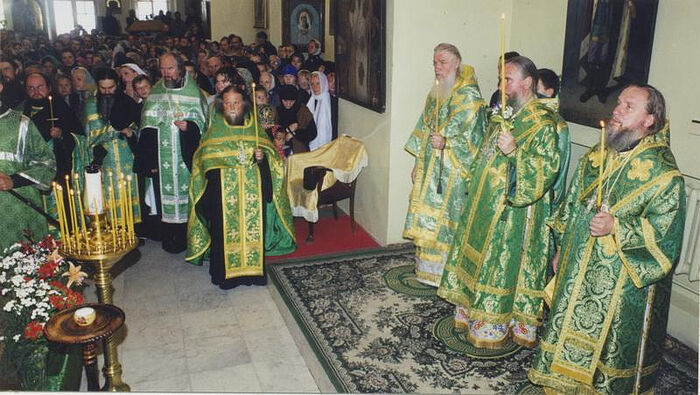 Solemn moleben with an akthist before the newly discovered holy relics of seven Optina Elders
Solemn moleben with an akthist before the newly discovered holy relics of seven Optina Elders
After the moleben, everyone reverently venerated the holy relics of the Optina Elders.
Minutes of the meeting on the examination of the relics of the Optina Elders
On October 1, 1998, with the blessing of His Holiness Patriarch Alexei of Moscow and All Russia, the following people arrived at Optina Monastery to clarify the issues that arose in connection with the uncovering of the relics of the Elders on July 7-9 this year:
- His Eminence Archbishop Arseny of Istra, vicar of His Holiness Patriarch Alexei of Moscow and All Russia
- Tatiana Ivanovna Alexeeva, senior researcher of the Research Institute and Museum of Anthropology of Moscow State University, doctor of Historical Sciences, corresponding member of the Russian Academy of Sciences, professor
- Galina Vyacheslavovna Lebedinskaya, candidate of Biological Sciences, senior researcher at the Institute of Ethnology and Anthropology of the Russian Academy of Sciences
- Maria Borisovna Mednikova, candidate of Biological Sciences, senior researcher at the Institute of Archaeology of the Russian Academy of Sciences
- Sergei Alexeevich Belyaev, senior researcher at the Institute of Modern History, head of the group, candidate of Historical Sciences
Participating from the monastery:
- Archimandrite Benedict (Penkov), abbot of the Optina Hermitage
- Igumen Dosithei (Shamanaev), monastery steward
- Igumen Tikhon (Borisov), dean of the skete
- Igumen Anthony (Gavrilov), assistant to the brethren’s confessor
- Hieromonk Philaret (Degtyarev), confessor for the laity
- Hieromonk Barsanuphy (Dydykin), brother of Optina Hermitage
First, the participants in the meeting heard the abbot’s report about the uncovering of the relics of the Optina Elders on July 7-9 of this year. The participants were familiarized with photo documentation and bibliographic testimonies preserved from the time of the existence of the part of the necropolis where the graves of the Elders were, in its entirety.
After that, the participants went to the Entrance of the Theotokos Cathedral, where the uncovered relics of the Optina Elders were placed until the time of their transfer to the new Vladimir Icon Church. There the participants had the chance to get acquainted with the Elders’ holy relics—their skeletal remains. After comparing photos from the Elders’ lifetimes with their remains, and identifying pathological features on some of the skeletons corresponding to known wounds and diseases the Elders had suffered from, the brethren’s conclusions that the relics belonged to the Elders Leo, Macarius, Ambrose, Hilarion, Anatoly (Zertsalov), Barsanuphius, Anatoly (Potapov), and Joseph were confirmed.
Thus, the anthropologists’ conclusions remove all previously existing perplexities. The results of the scientific survey will be presented in a special appendix from the anthropologists who participated in the work.
For the monastery brethren, who took an active part in the work, there wasn’t the slightest doubt in the authenticity of the discovered relics. But, since it was a Church-wide matter, and one to some degree of societal importance, it was decided to turn to anthropologists to give their conclusion.
On October 1, 1998, Archbishop Arseny, vicar of His Holiness Patriarch Alexei of Moscow and All Russia arrived at Optina Monastery, and with him a group of researchers who had the chance to get acquainted with the uncovered relics of the Elders. At the subsequent meeting, which was attended by representatives of the monastery brethren, the abbot’s report was heard.
In studying the relics, the experts took into account facts from the lives of the Elders. For example, it’s known that a wolf attacked Elder Leo in his youth and severely injured his leg, and Elder Macarius had a fracture in his right arm as a result of an accident during one of his trips. Traces of these injuries remained on the relics. All of this and much else was discovered during the examination. The anthropologists also studied photos and portraits from the Elders’ lifetimes, and in their final scientific conclusion, they fully confirmed that the relics uncovered truly belong to the aforementioned Optina Elders.
In their “Conclusion,” the anthropologists don’t touch upon the “fourth” and “sixth” burials, that is, of Elders Barsanuphius and Anatoly (Zertsalov). This is because the authenticity of the uncovered relics belonging to them never caused anyone even the slightest doubt.
The holy relics of St. Joseph, uncovered on October 16, 1988, were also examined by the anthropologists and they appear in their “Conclusion” as “the remains of the fifth burial.”
CONCLUSION
on the results of the anthropological examination
of the remains buried at the Optina Hermitage
During its visit to the Optina Hermitage, the anthropological commission got acquainted with the remains in order to possibly identify to whom they belong.
During the visual examination, the characteristic features of those buried were noted, which can be correlated with the lives of the Optina Elders. All the remains studied by the commission belong to people who reposed in old age, and bear numerous traces of age-related changes...
Tranaslator’s note: The conclusion goes on to discuss in-depth the physical characteristics of the remains that were uncovered and examined.
… The results of the examination of the remains buried at the Optina Hermitage and comparisons with photos of the Optina Elders indicate that the remains of the first buried belong to Elder Leo, the remains of the second to Elder Macarius, the remains of the third to Elder Hilarion, the remains of the fifth to Elder Joseph, the remains of the seventh to Elder Anatoly (Potapov), and the remains of the eighth to Elder Ambrose.
***
Once the anthropological commission completed its work, Archbishop Arseny of Istra and the monastery brethren served a moleben before the holy relics of the Optina Elders that had been uncovered.


